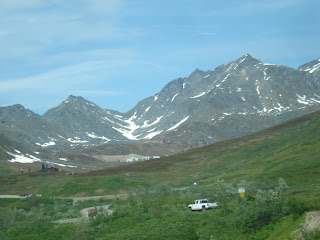Sunday: Left Anchorage for Palmer and the Independence Gold Mine Historical Site.
In 1935, Palmer became the site of the most unusual experiments in American history a planned agricultural colony and recruited farm families from Minnesota, Wisconsin and Michigan to join the colony because it was thought hardy farmers of Scandinavian descent would have a natural advantage over other ethnic groups. Although the failure rate was high, many descendants still live in this area--Matanuska Valley.
Palmer is Alaska's only community that developed primarily from agriculture Growing season is about 115
days long, but the unique micro climate produces amazing giant vegetables--ie. 126 lbs Cabbage.
Roads are bit more flatter, you betcha..
Karen was quite apprehensive when we left the main road to find the gold mine
And sure enough--road construction!
Did we have to go this way? I saw another route!
Little Susitna River
Back on the hard roadWhere are you taking me?
Following the river
Are we there yet?
Beautiful river
Still going up..are we the only ones' out here?
Another Jeep and another behind...feel better now!Matanuska Valley below
Stopped here to camp for the night--Gold Mint Trail Head Park
Nice view of the river from our site
We were the only RV and 1 tenter to stay!
I don't know..there's all kinds of BEAR signs...
I'm staying in the camper!!! 11pm and it's still this light.
We unhitched and took the Jeep to the mine--a steep climbNotice- above the tree line
Gotta pay to get in ...not too much is free in Alaska Buzz.
Higher we go
High in the mountains now
This is the Independence Gold Mine
In 1906, Robert Hatcher found a vein of quartz and gold on the top of these mountains and
staked out a claim. It wasn't until 1937, when they began to mine these mountains.
There were over 200 miners and workers at this mine. Because of World War II, and the price of gold, the mine closed in 1951. Left to decay until the late 1970's, the mine and land around were donated to the State of Alaska. It took 10 years to become a state park.
Mess Hall
Another mine next door--owned by a 75 year old man who has lived there since he was one.
He lives here year round..skies down to "Boom Town" in the winter for supplies and
snowshoes back!
Bunk House #1 built in 1938Mine Portal on Granite Mountain--top of peak where first gold found.
Mine portal on Skyscraper Mountain
Mess Hall--fed 160 miners a day
Their food was served to them on porcelain dishes and
cooked by a chief-the owner wanted his workers to be
treated well. They made good money in those times at his mine.
Another view--painted in silver with red trimhuge kitchen and bakery--the chef was the most important worker here
and they ate as much as they wanted for free---rooms were free too.
The building was constructed in a cross design-could be seen from the sky!
Looking down on the train tracks that brought the ore down to be processed
The guide said it snowed here June 13, had to take a snow machine to get up here.
Ruins of the Old milling and power plant
Train with a scoop front for "mucking" out the rock after blasting
Bunk House #2 50 men housed here-2 per room
Just down the hill, was "Boomtown" where the married couples had homes--about 20.
And the singles went for other enjoyment!
Engineering Office and School for the children.
Assay Office In its peak year, 1941, APC employed 204 men, blasted nearly a dozen miles of tunnels, and produced 34,416 ounces of gold worth $1,204,560; today $17,208,000.
Apartment that housed 4 families-Supervisors and their families
Happy we weren't Miners back then -
It's June 23 and still cold-couldn't take -40 degrees wintertime.
















































No comments:
Post a Comment